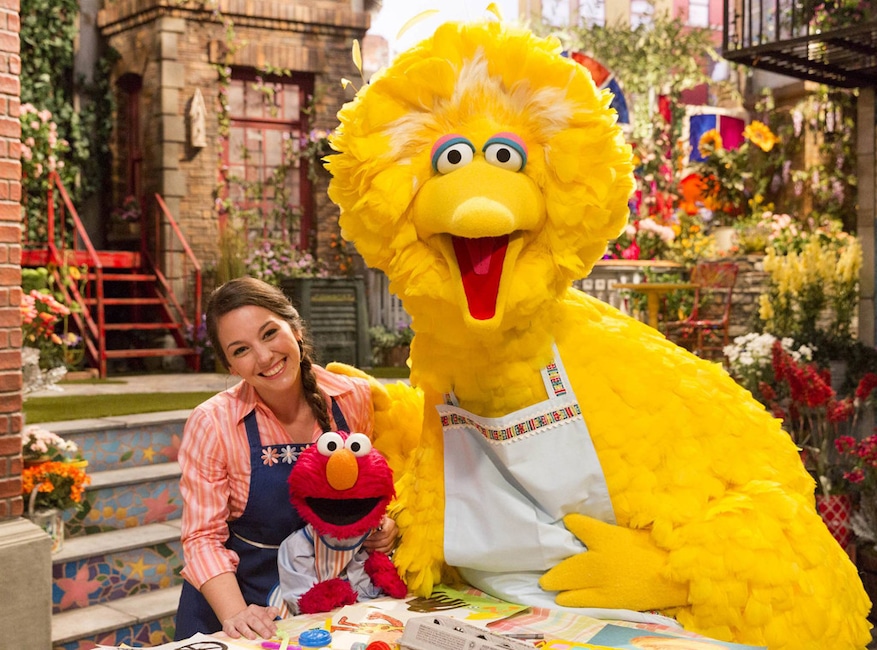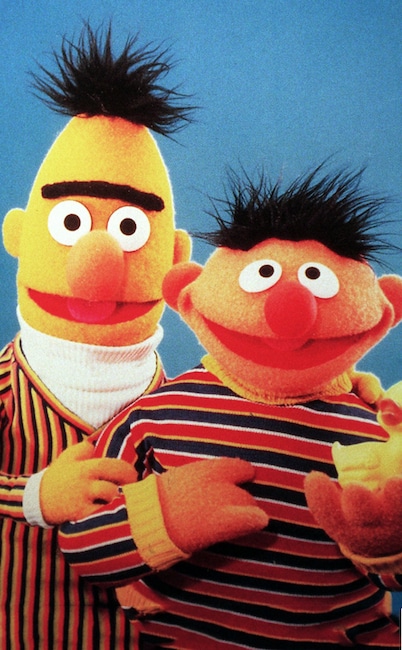Guess what? We can finally tell you how to get to Sesame Street.
The iconic children’s series turns 50 on Nov. 10, and half of a century later, it’s still one of the most beloved TV shows—by children and adults.
After debuting in 1969, Sesame Street made household names out of Jim Henson‘s beloved Muppets like Big Bird, Elmo, Cookie Monster and more, and helped educate children about letters, numbers, and, over time, more serious subject matters, like death, divorce and drug addiction.
All these years (and 4,500 episodes!) later, the show is as popular as ever, with a reported 100 percent brand recognition globally, airing in 180 countries.
But did you know one state actually banned the series, which moved from PBS to HBO in 2015 (and is set to jump to HBO Max)? And that two Muppets were retired after sparking controversy? Oh, and that Kermit the Frog actually exited the show after just one season?
Those are just a few of the surprising secrets we unearthed about Sesame Street on its 50th birthday…
HBO
1. Sesame Street has won 189 Emmys, more than any other TV series and reaches over 150 million children across the globe. Today, there are more than 150 versions of the show being produced in 70 languages, with 1 million kids playing with a Sesame Street toy on any given day, per Sesame Workshop.
2. The idea for the show was sparked by a dinner party conversation that happened in 1966, when Joan Ganz Cooney, the Sesame Workshop co-founder who was then working as a producer, was asked, “Do you think [TV] can teach anything?” according to The Hollywood Reporter.

HBO
3. Big Bird, a 6-year-old 8’2″ tall yellow bird, is one of Sesame Street‘s original characters and is one of the most iconic children’s characters in all of pop culture. Puppeteer Caroll Spinney was the man behind the character until he retired In 2018, with Matt Vogel then taking over.
4. In the costume, Spinney was unable to see, so he had a small monitor inside the chest that gave him a camera-view of himself. As he had to operate Big Bird’s head with his right hand, Big Bird’s right arm was mostly inactive. The costume? It was based on Henson’s sketches and used over 4,000 feathers.

James Keyser/The LIFE Images Collection via Getty Images/Getty Images
5. It wasn’t until season 30 (1998) that Elmo finally got his own segment, Elmo’s World, due to the character’s immense popularity. For example…
6. The decision clearly was a smart one, as Elmo had become one of the show’s iconic personalities and the Tickle Me Elmo toy caused a craze in 1996, with stores selling out of the toy in record numbers ahead of Christmas. People were arrested for fighting over the doll, and some NYC parents hungry for the doll attempted to storm a delivery truck. And during a Midnight Madness sale on December 14, a Wal-Mart employee in Canada was injured in “Elmo-mania” when 300 shoppers ran after him when they saw he had the box of toys. That holiday season, one million Tickle Me Elmos were sold.
Article continues below

iphone/Sesame Street
7. In 2004, Cookie Monster, who was initially designed by Henson to be used in food commercials, revealed his real first name: Sid! He was given his infamous nickname after her tried a cookie for the first time.
8. After childhood obesity became a bigger concern in the 2000s, the Internet rumor mill claimed Cookie Monster’s name would be changed to Veggie Monster. Alas, his cookie appetite had not been curbed by the show.
“We are not putting him on a diet,” said his spokesman at the time. “And we would never take the position of no sugar. We’re teaching him moderation.” He was given a new song, “A Cookie Is a Sometimes Food,” and new characters were introduced that offered tips about healthy eating and physical activity.

Zentralbild/DPA/ZUMAPRESS.com
9. After a former writer said in an interview he considered Bert and Ernie to be more than just roommates, Sesame Workshop released a statement clarifying the relationship between the two characters who had been on the show since it began:
“As we have always said, Bert and Ernie are best friends. They were created to teach preschoolers that people can be good friends with those who are very different from themselves,” the statement read. “Even though they are identified as male characters and possess many human traits and characteristics (as most Sesame Street Muppets do), they remain puppets, and do not have a sexual orientation.”

Jesse Grant
10. First celeb to guest star? Carol Burnett, with hundreds of major stars following suit “It was a marvelous show,” Burnett told THR of her trips to Sesame Street since her first appearance in 1969. I kept going back for more. I think one time I was an asparagus.”
11. A list of retired Muppets include Professor Hastings, Harvey Kneeslapper and Bruno the Trasman. A cul-de-sac called “Around the Corner” was shut down after five years in the ’90s after children were confused by the alley (which was turned into a parking lot).
12. While he was one of the original Muppets on the show, Kermit the Frog actually left Sesame Street after season one as Henson knew the character would become his signature Muppet. He would return in season three and go on to make appearances over the decades, while his replacement, Herbert Birdsfoot, was phased out after season five, though his assistant Grover became a fan-favorite.
Article continues below

Mgm/Kobal/Shutterstock
13. One episode that only aired once and was banned after because it caused an influx of letters from parents? A 1976 episode that featured Margaret Hamilton reprising her iconic role as the Wicked Witch of the West from The Wizard of Oz.
14. Two Muppets were retired due to controversies: Roosevelt Franklin, the first African-American puppet, was removed from the show in 1975 after five years after complaints from parents and critics alike that the character was racist, with Roosevelt becoming a source of racial tension. The other controversy involved Don Music, a composer Muppet who was on the show in the ’70s and ’80s and was known for banging his head against his piano. After parents called in to complain that their children were mimicking this behavior, he was retired from the show.
“We would never do something like that now because the research shows we have to help kids with self-regulation skills,” Rosemarie Truglio, Sesame Street’s senior VP of curriculum and content told THR. ”Banging your head is not an effective way to cope with your emotions.”

Steve Meddle/Shutterstock
15. In 1970, Sesame Street was banned in Mississippi after the State Commission for Educational Television to remove it from airing on TV because of racial grounds, the New York Times reported. ”Some of the members of the commission were very much opposed to showing the series because it uses a highly integrated cast of children,” a member of the committee said at the time. The ruling was reversed less than one month later.
16. In 2012, Elmo’s puppeteer Kevin Clash left the series after he was accused of having a sexual relationship with a man that began when his accuser was 16 years old. He denied the accusations.

David Attie/Getty Images
17. Mr. Hooper was one of the first four humans to appear on the show and ran Hooper’s Store, with Will Lee being the first actor cast and he was on the s how until his death in 1982. Rather than recast the role, the producers decided to use the real-life tragedy to educate children on death in an episode that aired on Thanksgiving Day 1983.
“We felt we ought to deal with it head-on,” Dulcy Singer, the program’s executive producer, explained at the time. “If we left it unsaid, kids would notice. Our instincts told us to be honest and straightforward.”
18. In season 33, the show changed its structure dramatically, becoming more narrative, explaining it was due to their demographic going even younger: 2-4 year-olds.
“We basically deconstructed the show,” co-EP Arlene Sherman told The San Francisco Gate at the time. “It’s not a magazine format anymore. It’s more like the ‘Sesame’ hour. Children will be able to navigate through it easier.” The changes also included increasing Cookie Monster and Count von Count’s roles and a new Spanish World of the Day segment.
Article continues below

PBS
19. Hard to imagine now, but the first two seasons of Sesame Street actually have a warning on them: “Sesame Street: Old School is adults-only: These early Sesame Street episodes are intended for grown-ups and may not suit the needs of today’s preschool children,” according to The New York Times.
20. Oh, and in case you were wondering, here is how to get to Sesame Street: Take the “R” or “V” train to Steinway Street, walk west on 34th Avenue and then three blocks to 36th Street. Make a left on 36th and the entrance to Kaufman Astoria Studios in Queens is mid-block.
Don’t miss E! News every weeknight at 7, only on E!
